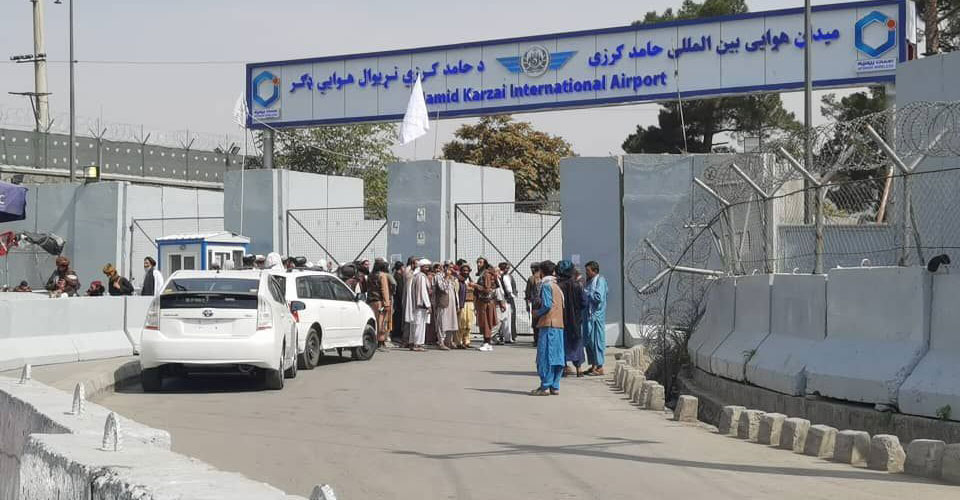We support our Publishers and Content Creators. You can view this story on their website by CLICKING HERE.
U.S. State Department officials dispatched at the eleventh hour to assist in the Afghanistan evacuation updated tactics in real time as chaotic conditions on the ground rendered any prior planning meaningless, according to new testimony released Thursday.
The military began planning to carry out a noncombatant evacuation operation for U.S. personnel as early as April, before the Taliban had overrun most of the country, but the U.S. ambassador in Kabul did not call for the operation until the Taliban captured Kabul on Aug. 15, 2021, according to testimony released separately on Monday.
Three officials who arrived in August—John Bass, James DeHart, and Jayne Howell—said they adapted constantly to increasingly dangerous and disorganized conditions at Hamid Karzai International Airport in Afghanistan, with changing guidance from Washington and no formulated plan to direct their decisions.
“We were already in the midst of executing an evacuation that substantially exceeded, I think, the scope and scale of what had been contemplated,” Bass, the top State Department coordinator for the evacuation, said in the interview.
Bass, DeHart, and Howell interviewed with the House Foreign Affairs Committee in 2023 and early 2024. Chairman Rep. Michael McCaul, R-Texas, intends to release a report later in 2024 drawn from about a dozen testimonies in total and the State Department’s own internal review as part of his continuing investigation into the withdrawal, CNN reported.
The State Department had rushed the officials with virtually no notice to Afghanistan in the final days of the U.S. military presence in Afghanistan, picked for their extensive prior experience in Afghanistan, CNN reported.
They testified to receiving little guidance from the State Department beyond doing their utmost to facilitate the evacuation.
“Given how fluid the situation was on the ground, I’m not sure that additional preparation time would have yielded a significant benefit,” Bass said.
They also said they did not see any written evacuation plans.

Members of the Taliban arrive at Hamid Karzai International Airport after the completion of the U.S. withdrawal from Afghanistan on Aug. 31, 2021, in Kabul, Afghanistan. (Photo: Sayed Khodaiberdi Sadat/Anadolu Agency/Getty Images)
“The situation was so fluid, I cannot emphasize enough to you that minute to minute, what was happening was changing what—how the travelers were accessing the compound was changing, what security event may have happened around was changed, where we could operate,” said Howell, who led consular evacuation operations after Kabul’s fall.
A planning team on the ground worked nonstop with the Marines on guard to adjust, but “inputs to that planning operation were constant,” Howell added.
Top military officials, including then-Chairman of the Joint Chiefs of Staff Mark Milley, have said that much of the chaos and embarrassment could have been avoided if the noncombatant evacuation operation began earlier, according to CNN.
However, the State Department has not conceded that it unwisely delayed requesting the military to initiate the noncombatant evacuation operation.
“Each of the current and former Department officials interviewed by the Committee worked alongside thousands of other personnel from the Department and the military to evacuate nearly 124,000 U.S. citizens, Afghan allies, and international partners, a massive and extremely challenging military, diplomatic, and humanitarian undertaking conducted under extraordinary circumstances,” a State Department official told CNN in response to the new testimonies.
The Taliban controlled access points to the airport compound and at times barred people who qualified for evacuation from entering. Desperate Afghans crowded the perimeter barriers of the airport, and at one point tens of thousands broke through barriers and spilled into the passenger terminal, Howell said.
“We had to, I would say, create from scratch tactical operations that would get our priority people into the airport,” explained DeHart, who served as deputy to acting deputy secretary Bass at the time.
“Nobody predicted the situation that we faced,” DeHart said. Still, he testified the State Department’s response to unpredictable rapid-fire events was methodical and proactive.
Guidance on who was allowed into the airport compound changed several times, for example, he said. Initially women and children who made it to the gate could be admitted “from a humanitarian perspective,” but as the volume of people rose to unmanageable proportions—the U.S. government did not have the means to transport them or safe havens to place them in after an evacuation—the rules for admittance became stricter.
“That was very difficult for consular officers, you know, to realize that maybe they just turned away somebody that now could be admitted, or had admitted somebody that now would be turned away. On a human level, that’s quite frustrating, but it was required because of the circumstances,” he said.
Originally published by The Daily Caller News Foundation

 Conservative
Conservative  Search
Search Trending
Trending Current News
Current News 





